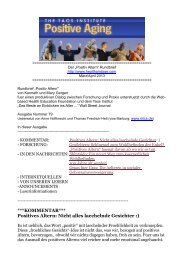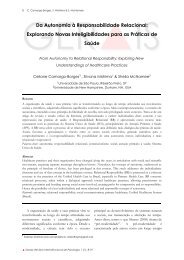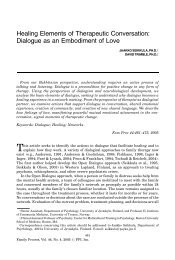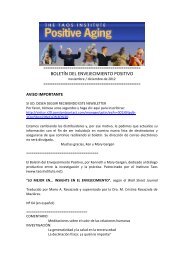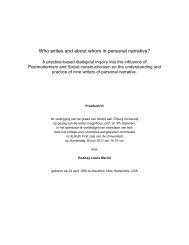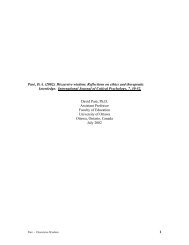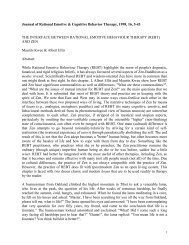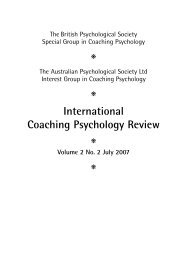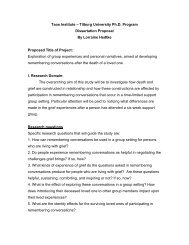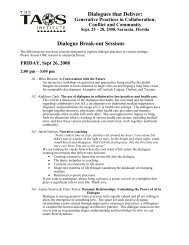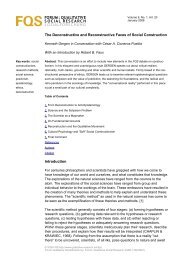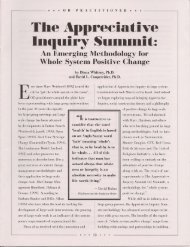Article (pdf ) - The Appreciative Inquiry Commons
Article (pdf ) - The Appreciative Inquiry Commons
Article (pdf ) - The Appreciative Inquiry Commons
Create successful ePaper yourself
Turn your PDF publications into a flip-book with our unique Google optimized e-Paper software.
In this issue you will find articles examining:<br />
• Career Development<br />
• Change Management<br />
• Cultural Intervention<br />
• Leadership Development<br />
• Knowledge Management<br />
• Organization Capability/Effectiveness<br />
• Organization Design/Transformation<br />
• Talent Management<br />
• Team Building/Effectiveness<br />
Featuring best internal<br />
OD practices from the<br />
following organizations<br />
around the globe<br />
including Europe,<br />
Asia and Africa:<br />
Beaumont Hospitals<br />
BP Castrol Marine<br />
Canadian Tire Corporation<br />
Chevron<br />
Corning<br />
Ethicon Endo-Surgery, Inc.<br />
Honeywell<br />
Janssen Pharmaceutica<br />
Johnson & Johnson Health<br />
Care Systems, Inc.<br />
McDonald’s<br />
Mkombozi Centre for Street<br />
Children<br />
Standard Chartered Bank<br />
Takeda Pharmaceuticals<br />
<strong>The</strong> Walt Disney Company<br />
(Asia Pacific) Limited<br />
United States Air Force<br />
Yale New Haven Health<br />
System<br />
Fall 2007<br />
Volume 25: number 3
O r g a n i z a t i o n D e v e l o p m e n t J o u r n a l<br />
Table of Contents<br />
From the Editor<br />
Best Global Practices in Internal Organizational Development ............................................5<br />
Thiet (Ted) K. Nguyen, Johnson & Johnson<br />
<strong>Article</strong>s<br />
CHANGE MANAGEMENT AND CULTURAL INTERVENTION<br />
A Time of Transition: Lessons in Global OD from a Successful Japanese Firm ................................. 13<br />
Robert C. Kjar, Takeda Pharmaceuticals<br />
U.S. Air Force Wingman Culture: A Springboard for Organizational Development. .............................. 19<br />
Frank Budd, Colonel, USAF, Ph. D., Kirtland U.S. Air Force Base, NM<br />
Using Conceptual Learning Maps and Structured Dialogue to Facilitate Change at a Large Health System. ............. 25<br />
Jean Ann Larson, Beaumont Hospitals<br />
LEADERSHIP AND CAREER DEVELOPMENT<br />
A Systemic Approach to Career Development at McDonald’s. ............................................ 33<br />
Linda Rasins, Linda Rasins Consulting; Irene Franze, Bank of America; Steve Russell, McDonald’s North America<br />
Developing Your Talent to the Next Level: Five Best Practices for Leadership Development ....................... 39<br />
Deborah Miller, Canadian Tire Corporation, Limited, Ontario, Canada;<br />
Sergio Desmarais, University of Guelph, Ontario, Canada<br />
Fulfilling the Promise of Career Development: Getting to the “Heart” of the Matter ............................ 47<br />
Frans van de Ven, Janssen Pharmaceutica in Beerse, Belguim, A Johnson & Johnson Company<br />
High Impact Leadership Development ........................................................... 53<br />
Michael E. Pepe, Ph.D., Yale New Haven Health System<br />
KNOWLEDGE/TALENT MANAGEMENT<br />
Human Capital Measurement: From Insight to Action ................................................. 61<br />
Debbie Whitaker, Standard Chartered Bank; Laura Wilson, Standard Chartered Bank<br />
Lessons Learned About Lessons Learned. ......................................................... 67<br />
Jerry Wellman, Honeywell International<br />
ORGANIZATION CAPABILTY/EFFECTIVENESS<br />
Business Driven Action Learning: A Powerful Tool for Building World-class Entrepreneurial Business Leaders ........... 77<br />
Jane Horan, <strong>The</strong> Walt Disney Company (Asia Pacific) Limited<br />
Organization Development: Acting as One with the Business – Best Practices at Chevron Corporation ................ 83<br />
Oleen Miranda-Stone, Ph.D.; Michael C. Leary, Chevron<br />
<strong>The</strong> Annual HR Strategic Planning Process: Design and Facilitation Lessons from Corning Incorporated Human Resources . . 89<br />
Debbie Bennett, Corning, Inc.; Matthew Brush, Corning, Inc.<br />
Volume 25 • Number 3 • fall 2007 | p1
O r g a n i z a t i o n D e v e l o p m e n t J o u r n a l<br />
ORGANIZATION DESIGN/TRANSFORMATION<br />
Using OD to Enhance Shareholder Value: Delivering Business Results in BP Castrol Marine ....................... 99<br />
David Gilmour, Castrol Marine, BP plc; Anne Radford, <strong>Appreciative</strong> <strong>Inquiry</strong> Practitioner Journal<br />
Organizational Design for a Supply Chain Transformation: Best Practice at Johnson & Johnson Health Care Systems Inc . . 105<br />
Lizbeth Yacovone, Johnson & Johnson Health Care Systems Inc.<br />
Toolbox or Transformation: Is Organizational Development the Key to Unlocking the Potential of<br />
Civil Society Organizations in East Africa? ....................................................... 113<br />
Kate McAlpine, Mkombozi Centre for Street Children<br />
TEAM BUILDING/EFFECTIVENESS<br />
A Structured, Facilitated Team Approach to Innovation .............................................. 121<br />
Drew Boyd, Ethicon Endo-Surgery, Inc., A Johnson & Johnson Company<br />
Academic Implications<br />
Analysis of Best Practices of Internal Consulting ................................................... 125<br />
Miriam Y. Lacey, Ph.D., Graziadio School of Business and Management, Pepperdine University;<br />
Teri C. Tomkins, Ph.D., Graziadio School of Business and Management, Pepperdine University<br />
<strong>The</strong> OD Journal special Edition Team Bios. ....................................................... 134<br />
COMMUNITY CONNECTIONS<br />
Calendar of Events ....................................................................... 153<br />
Advertising Guidelines for O.D. Journal ......................................................... 154<br />
Subscription Information ................................................................... 157<br />
In Appreciation ......................................................................... 158<br />
p2 | Volume 25 • Number 3 • fall 2007
O r g a n i z a t i o n D e v e l o p m e n t J o u r n a l<br />
Letter from the Editor:<br />
Best Global Practices in Internal Organization<br />
Development<br />
by Thiet (Ted) K. Nguyen, Johnson & Johnson<br />
I recently returned from a business trip to the Asia Pacific Region where I visited Japan, China, India, Singapore, Thailand,<br />
and Vietnam. Several weeks prior to this trip, I was in Europe visiting Germany, Switzerland, Belgium, and the UK<br />
supporting the Emea region talent management team with strategic projects. During my global business travels in the<br />
last several years, whether to emerging markets like Russia, Turkey, China, India and Vietnam or to established markets<br />
like the UK, Germany, Spain, Italy and Japan, I have come to appreciate the value our profession brings to drive change<br />
while enhancing organizational growth and vitality.<br />
From my perspective, I believe our profession is becoming localized in this global market place. Today, Western consultants<br />
are traveling to the East. Tomorrow, we may see Eastern consultants traveling West as the need for Western consultants<br />
traveling East diminishes. Today, we may export knowledge and talent from developed markets to help grow<br />
developing markets. Tomorrow, we may import talents from the emerging markets to help turnaround established<br />
markets. <strong>The</strong> global marketplace is changing rapidly, and I believe we need to continually upgrade our skills and reinvent<br />
our knowledge to remain vital as a profession.<br />
By publishing this global Special Edition, we expect to achieve our goal to help drive change and grow our profession.<br />
This Special Edition will benefit the HR/OD community in several ways:<br />
• Academic community – <strong>The</strong> academic community will find the content of these contributions of value to raise the<br />
awareness of current best internal practices. Program directors can be informed and encouraged to strengthen their<br />
curriculums and research directions. Graduate students may use this edition to leverage their classroom experience,<br />
as they prepare to enter the OD profession and compete for opportunities in the global marketplace.<br />
• Current practitioners – Both internal and external practitioners can use this knowledge to guide and grow their practice<br />
areas, enhance their skills, and strengthen their core competencies, by learning from other OD professionals.<br />
• Our clients and business partners – Potential and existing clients can be better informed of the capabilities OD<br />
professional can bring to enhance employee engagement and organizational growth and vitality.<br />
Since the May 2007 publication of the first of a three-volume set of the global Special Edition, we have received a<br />
number of congratulatory phone calls and emails from academics and practitioners. We have also received requests for<br />
copies from colleagues worldwide. Given the overwhelming interest level to the premier global Special Edition, our<br />
printer agreed to a second printing within two weeks of the initial publication. We appreciate your warm thoughts<br />
and forgiveness of any errors or omissions you may have found while reading the last edition.<br />
Content like this has never been captured or disseminated because internal practitioners tend not to have the luxury of<br />
time to write. This is the first time many of these authors took the time to document their work, secure the support of<br />
Volume 25 • Number 3 • fall 2007 | p3
O r g a n i z a t i o n D e v e l o p m e n t J o u r n a l<br />
their company to release the information, and share their internal efforts with all who are interested. We applaud all<br />
our authors for their trust in us, and their willingness to provide working papers without the benefit of professional<br />
editors. What readers will experience in this global Special Edition is truly the authentic voices of internal practitioners<br />
worldwide who share their stories from a place of caring and eagerness to advance the field of organization<br />
development.<br />
While this series is titled a best internal OD practice edition, no one associated with its production has judged or evaluated<br />
“a best global practice”. Rather, authors were encouraged to share what they perceived to be a best practice within<br />
their organization, whether that organization is a start-up company in India, a non-profit organization in the USA,<br />
an energy company in Africa, or a hi-tech company in China. We also chose not to judge whether an article fits the<br />
definition of organization development, since there are variations among the definitions of OD We recognized, too,<br />
that OD is practiced differently across geographies, countries, sectors, industries, organizations, groups and contexts.<br />
To share additional insights into their workplaces, many authors have generously provided a one-page reflection outlining<br />
their working environment, the benefits of the intervention as described in their paper, and finally, to share their<br />
take on the experience. In some articles, the reflection page includes one or two brief testimonials from their business<br />
partners, internal clients, and/or others who were directly affected by the interventions.<br />
This second global Special Edition is the collaborative labor of love of 20+ authors/co-authors and an all-volunteer<br />
team of 105 practitioners worldwide who have invested thousands of hours during the last year to bring this publication<br />
from concept to reality. Together, we have become actively engaged because of our passion and commitment to<br />
enhance the capabilities and reputation of our profession. Collectively, we share the common goal of advancing the<br />
field of organization development by strengthening the internal body of practice literature.<br />
We hope you will enjoy reading this global Special Edition. Look for the final volume in November 2007 when we<br />
will bring you the remaining 25 articles. As always, we welcome your feedback to help us continually improve.<br />
Thank you.<br />
Ted Nguyen<br />
New Brunswick, New Jersey<br />
July 2007<br />
p4 | Volume 25 • Number 3 • fall 2007
O r g a n i z a t i o n D e v e l o p m e n t J o u r n a l<br />
<strong>The</strong> OD Journal Special Edition Team Members<br />
EDITORS<br />
• Ted Nguyen, Editor<br />
• Dianne Clarke-Kudless - Peer Review Editor<br />
• Lucille Maddalena - Technical Editor<br />
• Linda Myers - Associate Editor<br />
• Elena Feliz, Hania Qubein - Copy Editors<br />
• Surjeet Rai-Lewis - Guest Editor<br />
• Sandy Becker, Andrew Cohn - Staff Editors<br />
PEER REVIEW COUNCIL<br />
Internal Practitioners<br />
• Lucille Adriaens - Philips (<strong>The</strong> Netherlands)<br />
• Evelina Ascalon - Credit Suisse (Switzerland)<br />
• Joe Bonito - Pfizer<br />
• Leslie Berks - Hewlett Packard<br />
• Dottie Brienza - Johnson & Johnson<br />
• Susan Burnett - Gap, Inc.<br />
• K A Chang - Singapore Exchange (Singapore)<br />
• Laura Christenson - Horizon Blue Cross Blue Shield<br />
• Allan Church - PepsiCo<br />
• Jose Conejos - Nokia (Finland)<br />
• Carolyn Davis - Abbott Laboratories<br />
• Brent deMoville - Allergan<br />
• Gerald Dietz - SAP AG (Germany)<br />
• Sue Dodsworth - Kimberly Clark Corp.<br />
• Tamar Elkeles - Qualcomm<br />
• Marilyn Figlar - Lockheed Martin<br />
• Anika Gakovic - HSBC Group<br />
• Stefan Gartner - Amgen<br />
• Lisa Geller - Honeywell<br />
• Ann Giese - Motorola<br />
• Jaime Gonzales - Warner Bros.<br />
• Linda Gottschalk - American Standard Cos<br />
• Dee Grosso - Solstice Neurosciences<br />
• Hope Greenfield - Lehman Brothers<br />
• Barbara Gutmann - Volkswagen (Germany)<br />
• Ron Hadley - Wyeth Pharmaceuticals<br />
• Bill Hector - Citigroup<br />
• Art Heeney - DuPont<br />
• Bob Hoffman - Novartis<br />
• Bill Hunt - Raytheon<br />
• Angela Hyde - AstraZeneca (UK)<br />
• Julian Kaufmann - Tyco International<br />
• Barbara Keen - Bristol Myers Squibb<br />
• Louise Korver-Swanson - Bank of America<br />
• Steve John - Sanofi-Aventis<br />
• Leslie Joyce - Home Depot<br />
• Fernando Lanzer - ABN AMRO (<strong>The</strong> Netherlands)<br />
• Keith Lawrence - Procter & Gamble<br />
• Sang Seub Lee - LG Electronics (Korea)<br />
• Iris Lemmer - Microsoft<br />
• David Lipsky - Sony<br />
• Lori Malcolm - Wal-Mart<br />
• Cindy Marlowe - Berlex Labs<br />
• Kristin Meade - Quest Diagnostics<br />
• Krystin Mitchell - 7-Eleven, Inc.<br />
• Bernd Moehle - Nestle (Switzerland)<br />
• Kenny Moore - Keyspan Energy<br />
• Jay Morris - Trinity Health<br />
• Vas Nair - Schering Plough<br />
• Nina Dankfort-Nevel - General Electric (China)<br />
• David Owens - Bausch & Lomb<br />
• Greg Parker - Shell (<strong>The</strong> Netherlands)<br />
• Patricia Pedigo - IBM<br />
• Michael Pepe - Yale New Haven Health System<br />
• Carol Pledger - Goldman Sachs<br />
• Mary Plunkett - British Petroleum (UK)<br />
• Michele Prenoveau - Morgan Stanley<br />
• Paul Roithmayr- TV Guide<br />
• Renee Russell - Avon<br />
• Robert Ryncarz - Merck & Co<br />
• Rick Sawyer - Fujifilm USA<br />
• Mike Stafford - Starbucks Coffee Company<br />
• Joan Szymonifka - L’Oreal<br />
• Sheila Person-Scott - Wachovia Bank<br />
• Vera Vitels - Time Warner<br />
• Renee Wallace - Ahold<br />
• Kevin Wilde - General Mills<br />
• Kathy Zukof - New York University<br />
Volume 25 • Number 3 • fall 2007 | p5
O r g a n i z a t i o n D e v e l o p m e n t J o u r n a l<br />
External Practitioners<br />
• Lilian Abrams - Abrams & Associates<br />
• Seymour Adler - Aon Consulting<br />
• Michael Broom - Center for Human Systems<br />
• Dianne Clarke-Kudless<br />
• Andrew Cohn - Lighthouse Consulting<br />
• Edana Desatnick - Edana Desatnick Consulting, LLC<br />
• Vicki Foley - Lee Hetch Harrison<br />
• Mauricio Goldstein - Pulsus Consulting Group<br />
• David Jamieson - Jamieson Consulting Group<br />
• Lucille Maddalena - Maddalena Transition<br />
Management<br />
• Jeanne Maes - University of South Alabama<br />
• Cynthia Matthew - Wesleyan University<br />
• Linda Myers - WorldWise<br />
• Joy McGovern - Right Management<br />
• Rosa Colon - Global Talent Excellence, LLC<br />
• Valerie Norton<br />
• Lori Peterson - Integral Consulting Group<br />
• Marianne Tracy - Development Dimensions<br />
International<br />
• Jason Wingard - ePals Foundation<br />
• Jeana Wirtenberg - Jeana Wirtenberg & Associates<br />
• Andrea Zintz - Hudson Talent Management<br />
LIAISON TEAM<br />
Liaison with HRCI (SHRM)<br />
• Linda Myers - SHRM Global HR Certification Team<br />
Liaison with various academic institutions<br />
• Seymour Adler - NYU School of Applied Psychology<br />
• Sandy Becker - Rutgers Business School<br />
• Dianne Clarke-Kudless - Rutgers Organizational<br />
Psychology Program<br />
• Rosa Colon - Benedictine University<br />
• Edana Desatnick - Duke Corporate Education<br />
• Wei Huang - New York University<br />
• Miriam Lacey - Pepperdine Master OD Program<br />
• David Jamieson - Pepperdine Doctoral OD Program<br />
• Steve John - Columbia University<br />
• Jeanne Maes - University of South Alabama<br />
• Cynthia Matthew - Wesleyan University<br />
• Linda Myers - Harvard University<br />
• Lori Peterson - Augsburg College MBA Program<br />
• Renee Russell - Duke MBA Program<br />
• Jeana Wirtenberg - Fairleigh Dickinson University<br />
• Andrea Zintz - Fielding Graduate University<br />
SPECIAL EDITION STAFF<br />
Project Managers<br />
• Wei Huang - Crossing Over - Volume I<br />
• Nina Wortzel-Hoffman - Johnson & Johnson -<br />
Volume II<br />
• Elaine Steiner - Chanel - Volume III<br />
Design/Layout Team<br />
• Elena Feliz<br />
• Hania Qubein<br />
• Rita Witherly - MoZen Inc.<br />
• Don Michalowski - Ruby Window Creative Group<br />
Final Editing Team<br />
• Linda Myers - Associate Editor<br />
• Sandy Becker - Rutgers Business School<br />
• Helen T. Cooke - Cooke Consulting Group<br />
• Jean Hurd - Janus Consulting<br />
• Patricia Santen - Novartis<br />
• Donna Lue Quee - Hess Corporation<br />
• Sarah Boltizar - Johnson & Johnson<br />
• Sharon Snyder<br />
• Patricia Polanco Licata - New Heights Consulting<br />
• Mary Kay Ross - AT&T<br />
Proofreaders<br />
• Elena Feliz<br />
• Janice Lee Juvrud<br />
• Deborah Melnick - Chanel<br />
• Bettina Neiderhart<br />
• Joan Poling<br />
• Pat Samperi<br />
Guest Reviewers<br />
• Sandy Becker, Rutgers Business School<br />
• Sharon Blunt - Wal-Mart<br />
• Lable Braun - Dialogic<br />
• Roy Chen - Johnson & Johnson<br />
• Helen T. Cooke - Cooke Consulting Group<br />
• Jean Hurd - Janus Consulting<br />
• Surjeet Rai-Lewis - Johnson & Johnson Canada<br />
• Donna Lue Quee - Hess Corporation<br />
• Patricia Santen - Novartis<br />
p6 | Volume 25 • Number 3 • fall 2007
O r g a n i z a t i o n D e v e l o p m e n t J o u r n a l<br />
Using OD to Enhance Shareholder Value:<br />
Delivering Business Results in BP Castrol Marine<br />
David Gilmour, Castrol Marine, BP plc<br />
Anne Radford, <strong>Appreciative</strong> <strong>Inquiry</strong> Practitioner Journal<br />
Abstract<br />
During the turnaround at BP Castrol Marine, operating<br />
costs were reduced, customer satisfaction improved and<br />
gross profits increased. OD was the key to enhanced<br />
shareholder value. <strong>Appreciative</strong> <strong>Inquiry</strong> was the vehicle<br />
chosen to deliver the results by discovering best practice<br />
at BP Castrol Marine, which generated the way forward.<br />
<strong>The</strong> greater goal of transformation was to thrive, not just<br />
survive. David Gilmour and his team did this by creating<br />
a culture of commitment and discipline.<br />
Introduction<br />
<strong>The</strong> overall purpose of the paper is to show how OD is<br />
an enhancer of shareholder value. During the two-year<br />
period from 2004 to 2006, total operating cost of the<br />
business was reduced, customer satisfaction improved<br />
and gross profit increased. <strong>The</strong> Return on Invested Capital<br />
(ROIC) and Earnings Before Interest, Tax and Debt<br />
repayments (EBITDA), ratios used by analysts to value<br />
and price business, improved. This paper shows how<br />
these business results were achieved and the cultural<br />
transformation that took place.<br />
When I was appointed to Castrol Marine in July 2004,<br />
the situation was clear: there was a need for change due<br />
to the lack of clarity in a number of key areas: customer<br />
segments, brand positioning, disappointing financial<br />
results, declining customer satisfaction and unclear<br />
strategic direction of the business for employees. My<br />
remit was to address each of these areas.<br />
I had a choice of how to deliver the results: there were<br />
many options within BP itself and I was aware of the<br />
traditional method, which is for a managing director to<br />
decide where and how to reduce costs and for people to<br />
implement that decision. I had the freedom to choose<br />
a new approach to deliver change: <strong>Appreciative</strong> <strong>Inquiry</strong><br />
(AI). I had learned about it in a workshop with Anne<br />
Radford and used it in various ways in my previous positions.<br />
For me, the appeal of the AI approach was its emphasis<br />
on relational working, using affirmative language<br />
and building trust and commitment. <strong>The</strong> potential of AI<br />
was that people in the same location, across regions and<br />
throughout the business would work together to discover<br />
collectively best practices in their operations and generate<br />
a way forward. Strategic issues would be linked at the<br />
same time with operational issues, and staff demoralised<br />
by earlier poor business performance and fearful of business<br />
closure would be actively involved in the business<br />
turnaround.<br />
After my appointment I asked Anne to work with me as<br />
my thinking partner which she has been for the last three<br />
years. Although this article is written from my perspective,<br />
it reflects the thinking she and I have done over that<br />
time. Also, the points I have chosen to emphasise are the<br />
ones that I found compelling as a business leader – these<br />
may be different from the ones an OD practitioner would<br />
choose to focus on.<br />
This case study is an important addition to the growing<br />
set of examples where positive change approaches are an<br />
integral part of delivering major business improvements.<br />
This article is in three sections: first, background information<br />
on the challenges in the Castrol Marine business;<br />
second, cultural and business improvements during the<br />
two-year period 2004-2006; third, the OD approach,<br />
including tools and techniques used during this time.<br />
1. Background information and Business Challenge<br />
1.1 Background Information on the Castrol Marine<br />
business: Castrol Marine is a Performance Unit operating<br />
within the International Marine business unit within<br />
Refining and Marketing in BP plc. International Marine<br />
markets fuels and lubricants to shipping companies<br />
around the world. International Marine is a $5B+<br />
turnover business with over 700 employees.<br />
Volume 25 • Number 3 • FALL 2007 | p97
Castrol Marine is a global marine lubricants marketing<br />
business selling and marketing in over 70 countries and<br />
has sales, marketing and technical teams resident in<br />
more than 40 countries. Castrol Marine has been in<br />
business for over 100 years and can trace its roots to the<br />
pioneering days of marine lubrication to WB Dicks, a<br />
company trading 150 years ago. It has a strong reputation<br />
for customer focus, flexibility and technical know-how<br />
and is positioned as the premium player in the market.<br />
<strong>The</strong> employees, over 150 sales, technical and customer<br />
service staff, have considerable pride in the brand and<br />
in their track record delivering customer satisfaction.<br />
1.2 <strong>The</strong> Organisational and Business Challenges:<br />
Castrol Marine was acquired by BP plc in 2000. This integration<br />
was especially challenging as BP Marine itself<br />
was undergoing a significant business transformation<br />
through internal reorganisation, development of joint<br />
ventures aimed at transforming the marine marketplace<br />
and a significant systems implementation. <strong>The</strong> Castrol<br />
acquisition was judged to be a small but a valuable addition<br />
to its business. However the size and scale of this<br />
integration was underestimated.<br />
Despite the best endeavours of the management, the<br />
business lost momentum internally and in the market<br />
place, and its business performance declined rapidly.<br />
A major strategic review and implementation were<br />
initiated during 2003. <strong>The</strong> outcome was a significant<br />
re-orientation of the business to define priority segments,<br />
position the brand clearly and provide internal<br />
functional support aligned with the segments.<br />
I was appointed to the role of Performance Unit leader,<br />
Castrol Marine on July 1st 2004 with the aim of implementing<br />
this business strategy. In addition to improving<br />
the business, my main challenge was employee engagement<br />
to deliver the business objectives. A new management<br />
team was also in place by September 1st 2004.<br />
<strong>The</strong>ir crucial role is described later.<br />
2. Business and Cultural Improvements from 2004<br />
to 2006<br />
2.1 Impact of OD on shareholder value: During the<br />
two-year period, results from formal internal surveys<br />
showed a significant increase in areas such as trust and<br />
respect that people had for each other in the business.<br />
<strong>The</strong> impact of these improvements showed up in areas<br />
that affect shareholder value. A reduction in invoice errors<br />
led to a more timely dispatch of invoices improving<br />
cash generation – a key driver of dividend payout. Fewer<br />
errors also meant less manual intervention i.e., lower<br />
costs of back-office administration reducing the total<br />
operating costs of the business.<br />
Figure 1: Decline in Invoice Error Rates i<br />
Another key area was improving customer satisfaction.<br />
This allowed an increase in gross profit on the same cost<br />
base raising the return on sales and hence quality and<br />
size of profitability.<br />
Figure 2: Improvement in Customer Satisfaction ii<br />
Taken together the Return on Invested Capital (ROIC)<br />
and Earnings Before Interest, Tax and Debt Repayment<br />
(EBITDA) improved. <strong>The</strong>se are not the ratios used internally,<br />
but they are used by analysts to value and price<br />
businesses.<br />
2.2 Key Cultural and Financial Improvements.<br />
<strong>The</strong> following table shows some of the key cultural and<br />
financial improvements during the two-year period<br />
from 2004 to 2006:<br />
3. <strong>The</strong> OD Approach, and Tools and Techniques<br />
3.1 <strong>The</strong> OD Approach: Thought leaders in the field of<br />
Organisation Development are highlighting the emergence<br />
of a new OD: Robert Marshak contrasts classical<br />
OD based on the assumption of an objective, knowable<br />
reality with the new OD which looks at change as being<br />
cyclical and continuous, and operating from multi-cultural<br />
realities. iv Lessons are also being learned from complexity<br />
science with its emphasis on self-organising systems.<br />
<strong>The</strong> choice was made to work with the OD paradigm<br />
that emphasises participation, shared leadership and a<br />
p98 | Volume 25 • Number 3 • fall 2007
<strong>The</strong> Business Position in Q3 2004 <strong>The</strong> Business Position in Q3 2006<br />
<strong>The</strong> Market<br />
• Cost of goods starting its dramatic rise through rising<br />
oil prices<br />
• Fierce price competition as competitors seek market<br />
share gains leading to price and volume decline for<br />
Castrol Marine<br />
<strong>The</strong> Customer<br />
• Loyal customer base<br />
• Customers dissatisfied with the basic offer – poor invoicing,<br />
poor delivery performance – and a lack of<br />
clarity around what was the basic offer<br />
• Strong relationships between sales teams and customers’<br />
challenged by poor transactional processes.<br />
<strong>The</strong> Financial Performance<br />
• High fixed-cash costs<br />
• Some improvements started to be seen due to price<br />
initiatives<br />
Internal processes<br />
• Processes and relationships ‘broken’ due to Merger &<br />
Acquisition<br />
• Little investment in people capabilities<br />
• High levels of internal complexity<br />
• Lack of understanding of customer needs<br />
Organizational Climate<br />
• Business challenged by management to improve<br />
• Business was given space to implement strategy.<br />
• Fear of business failure and redundancies within the<br />
business<br />
• Transformation programme announced including<br />
staff reductions<br />
• Internal relationships between sales, supply, service<br />
and finance were fractured resulting in a strong blame<br />
culture<br />
Table 1: Comparison of the Business Position in 2004 versus 2006<br />
• Between 5 and 6 price increases implemented with a<br />
net improvement in pricing (this contrasts with price<br />
decline for previous decade)<br />
• Loyal customer base, no significant losses in customer<br />
numbers and acquisitions rate above market growth<br />
• Development of a ‘One Team’ culture enabling greater<br />
responsiveness and flexibility in meeting customer<br />
and internal needs<br />
• International marine split into two material<br />
operations, reflecting the success of marine lubricants<br />
and fuels.<br />
• Costs stabilised, overheads under control<br />
• Clear segmentation and understanding of customer<br />
needs<br />
• Simple offer, internal processes well defined,<br />
easier to work<br />
• Business is a reference for excellence in business<br />
marketing<br />
• Staff reductions have taken place and people<br />
relocated to other parts of BP Group<br />
• Pride in performance, rising employee morale<br />
• Major investment in people capability (leadership<br />
and sales and marketing)<br />
• Team is empowered and executes agreed actions with<br />
discipline and rigour iii<br />
culture of commitment and appropriate innovation.<br />
During this two-year period, leadership styles changed<br />
both for me and my management team and the culture<br />
of commitment grew.<br />
3.2 Using an <strong>Appreciative</strong> Leadership Style: Once I<br />
had decided to use <strong>Appreciative</strong> <strong>Inquiry</strong>, I explored the<br />
implications of AI principles for my leadership style. It<br />
did not feel like a choice – it felt like a part of my belief<br />
system. Using the methodology helped me understand<br />
its significance at a behavioural level and then as a way<br />
of life. <strong>The</strong> practical steps were worked out in coaching<br />
sessions with Anne Radford.<br />
This helped me develop an appreciative leadership style,<br />
together with the following beliefs:<br />
1: Valuing or believing in experimenting<br />
with diversity:<br />
• Opening up possibilities and co-creating the way<br />
forward with others<br />
• Having the arguments which surface differing views<br />
• Setting goals beyond the norm so that something<br />
new happens<br />
Volume 25 • Number 3 • fall 2007 | p99
• Creating a learning environment where the emphasis<br />
is on personal development and assisting others<br />
to become leaders<br />
• Bringing in consultants who are passionate about<br />
their profession and willing to apply AI principles to<br />
their areas of expertise<br />
2: Thinking that a leader’s way of working is an<br />
extension of how a great company should be.<br />
This includes aspects like:<br />
• How a leader would want to be treated<br />
• Wanting to leave a legacy in the business and<br />
in the industry<br />
3.3 Creating a Culture of Commitment<br />
3.3.1 Selecting the Team: Together with the support of<br />
my peers, I created a team during the reorganisation of<br />
the business united by: their passion for the business;<br />
their abilities to deliver significant change and establish<br />
strong relationships with others; a balance of youth and<br />
age; specific industry experience; and those who needed<br />
to prove something to themselves and others. Working as<br />
a team did not have a perfect start – some watched from<br />
the sidelines while others challenged hard. It was clear<br />
I was being watched and tested – once they saw I was<br />
being authentic they gave me their trust and confidence.<br />
While there have been some changes in the team, these<br />
have been fewer than the norm. Interestingly, the team<br />
now accepts new people well and attracts people who<br />
want to work with trust not control.<br />
3.3.2 <strong>The</strong> Team’s Role in the Change Effort: <strong>The</strong> team<br />
was crucial in taking the culture of commitment into the<br />
middle management and to the front line. <strong>The</strong>ir leadership<br />
behaviours, their role modelling the qualities and<br />
skills important in this style of leadership, and talking<br />
about what we were trying to achieve were key to creating<br />
the wave of change throughout the organisation.<br />
<strong>The</strong>y implemented key business priorities and brought<br />
insights and internal and external data to the team to<br />
establish priorities and select interventions.<br />
3.3.3 Building and Sustaining Authentic Relationships<br />
with the Team: I made it a priority to spend time<br />
with each member of the team focusing on their personal<br />
and career development and to support them publicly<br />
with their teams. I established 1-2 hours per month 1:1<br />
performance reviews on what was working well and<br />
what they were doing well. I disregarded performance<br />
blips and ensured they focused on the big goals and<br />
worked with them to succeed. I encouraged risk taking<br />
and establishing goals that were way beyond performance<br />
norms. Even when these were not achieved,<br />
our success was transparent to those outside.<br />
<strong>The</strong> team saw that I took personal risks in the media,<br />
took responsibility for success and any perceived failure<br />
and always reflected on what I was not able to do. I<br />
created a culture in the team where when we took the<br />
decision to deliver: we ‘signed in blood together’ and held<br />
each other to the highest standards and worked with<br />
each other with trust and relatedness, not punishment.<br />
Trust and relatedness are very important where people<br />
are located at huge distances from each other. It has been<br />
important that meetings emphasise these aspects and<br />
address tasks through peer coaching or ‘experience<br />
sharing’ sessions during the meetings.<br />
3.4 <strong>The</strong> Use of the AI Methodology. <strong>The</strong> AI methodology<br />
can be described briefly as: choosing an affirmative<br />
topic for an <strong>Inquiry</strong>; discovering what is working in a<br />
system; dreaming or envisioning a compelling image of<br />
the future by building on past successes; designing the<br />
relationships, systems and processes with others that will<br />
deliver the future; and looking at how the organisation<br />
will continue to learn, improvise and sustain its success –<br />
in other words, will reach its destiny. This cycle was used<br />
in many different settings, informal and formal, and a<br />
variety of business processes from product launches,<br />
team building, business process transformation and<br />
strategy development. One of the challenges in using<br />
this approach at the beginning of a change process is<br />
that instead of dealing with certainties in terms of known<br />
problems, there are many uncertainties: for example,<br />
what kind of future will be generated, and how to best to<br />
combine organisational strengths to deliver that future?<br />
Activity<br />
• Bringing teams together<br />
for the first time.<br />
• Product launch – Frontline<br />
engagement into a<br />
successful launch of a<br />
product<br />
• AI Summit with the Extended<br />
Leadership Team<br />
(Senior leadership conference)<br />
• Business process transformation<br />
• 333 coaching<br />
• Strategy development<br />
Table 2: Activities and <strong>Inquiry</strong> Topic<br />
<strong>Inquiry</strong> Topic<br />
•Being part of a great<br />
team<br />
• Delivering great<br />
launches<br />
• Extraordinary performance<br />
through inspirational<br />
sales leadership<br />
• How do we make life<br />
easy for ourselves and<br />
our customers?<br />
• 3 successes, 3 strengths<br />
you have brought to<br />
the business, 3 areas to<br />
pay attention to<br />
• What can we be best in<br />
the world at? What are<br />
our people passionate<br />
about?<br />
p100 | Volume 25 • Number 3 • fall 2007
Some specific times and ways the methodology was used<br />
are shown in Table 2.<br />
Conclusion<br />
A business turnaround is a single-minded, possibly<br />
brutal, activity focusing on short-term improvements to<br />
ensure survival. Transformation is much more complex,<br />
interlinking cultural aspects such as value delivery,<br />
employee motivation and pricing processes. It is aiming<br />
for a greater goal – thriving not surviving.<br />
Insights during this time period include:<br />
1 One key role of a leader is to unlock the true wishes<br />
and desires of people in the business – something beyond<br />
survival and towards powerful transformation.<br />
<strong>The</strong> classic way is to compartmentalise the business<br />
journey into linear episodes: turnaround ‡ transformation<br />
‡ generation for sustainability. My current<br />
reflection is that all three need to be present, each<br />
needing emphasis at different times. A heliotropic<br />
view, with the focus on hope and certainty of success,<br />
was very important, especially at the bleakest moments.<br />
2 Problem areas were dealt with, but not as something to<br />
be fixed. <strong>The</strong> lack of focus on the ‘problem’ was initially<br />
strange for the team but was very quickly welcomed.<br />
<strong>The</strong>ir energy grew as they saw and heard about successes<br />
throughout this global business. Problems or<br />
perceived problems were quickly left aside as successful<br />
interventions offered different routes for the<br />
organisation’s success.<br />
3 <strong>The</strong> focus was on dealing with the root of an issue and<br />
not being content with treating the symptoms. This<br />
meant stopping only when each intervention was<br />
complete and embedded. It also required patience and<br />
steadfastness from all levels of leadership. At times,<br />
progress seemed very slow but small.<br />
Authors’ Reflections<br />
As Director for Castrol Marine, my mandate was to put<br />
in place the strategy and associated programmes for a<br />
significant business turnaround. <strong>The</strong> major challenges<br />
included building motivation in my leadership team in<br />
the face of poor business performance and for them to<br />
build motivation in their front-line, customer-facing staff.<br />
We began by focusing on what was working well and<br />
creating a sense of hope, purpose and aspiration for the<br />
future of the business. Stories of success shared in a<br />
variety of ways across the business led to more willingness<br />
and commitment to continue turning around the<br />
business.<br />
I have learned a number of valuable lessons:<br />
• Bring the individual needs and the requirements of<br />
both the team and the business into a coherent frame.<br />
When done successfully, astonishing performance can<br />
be reached.<br />
• Do not expect support from all your colleagues. Advice<br />
focusing on short-term results, such as cutting costs,<br />
needs to be weighed carefully. Have courage of your<br />
convictions and a belief in the organisation beyond<br />
mere survival. It can be a lonely job at times. Select<br />
managers who have the desire to lead in different ways<br />
and who will engage the whole organisation.<br />
• Be ‘whole’ with your espoused philosophy. Although<br />
initially authenticity is treated with suspicion, consistency<br />
in approach and behaviours becomes highly<br />
valued and prized by the organisation.<br />
• Remain humble about your role in the success. Make<br />
sure the success is owned by all, and especially by the<br />
most junior in the organisation.<br />
• Find a coach and mentor who can offer independent<br />
and differing perspectives.<br />
• Utilize <strong>Appreciative</strong> <strong>Inquiry</strong> and focus on the positive.<br />
This approach can work in many different settings,<br />
business environments and with a wide variety of<br />
cultures and experience.<br />
I recognise that it is not common for a business leader to<br />
take on the OD function. My advice to business leaders<br />
who do not have the time or capability to develop such<br />
an approach is:<br />
• Appoint an OD professional to work with a small<br />
group of your senior managers to develop the approach.<br />
Form a close partnership with the consultant<br />
so you influence and co-create the strategy. Your role is<br />
to be the active and visible sponsor of the intervention,<br />
not of the HR or OD function.<br />
• Coach your leaders and focus on what is working.<br />
This creates the belief that something ‘different is<br />
happening’.<br />
• Know how to handle ‘failure’. An objective approach<br />
to facts and data while seeking the relevant learning<br />
reinforces strength even in the face of the normal<br />
day-to-day business challenges.<br />
• Be patient as your leaders re-orient to the new perspective<br />
– beliefs, values and trust build as you maintain<br />
a consistent approach.<br />
Volume 25 • Number 3 • fall 2007 | p101
• Don’t take this approach if you don’t believe in the<br />
strength and success of your organisation. Don’t do it<br />
if you believe that logic and analysis alone will make a<br />
difference. Don’t do it if you intend to revert to a directive,<br />
deficit-based approach if things don’t move in the<br />
way you want or the pace you want. Be consistent with<br />
your own beliefs and values.<br />
I was very pleased to see this appreciative leadership<br />
approach. Even though it isn’t very common, it has<br />
delivered extraordinary results which were beyond<br />
the incremental.<br />
- Business Unit Leader, BP plc<br />
Openness and an inclusion of the diversity of the<br />
entire team helped in sharing experiences across<br />
cultures.<br />
- Newly appointed Sales Manager, BP p<br />
Authors’ Bios<br />
David Gilmour leads a marine lubricant business in BP<br />
plc and has held roles in sales and marketing. David became<br />
interested in <strong>Appreciative</strong> <strong>Inquiry</strong> as Strategy Director:<br />
it gave him a new way of leading based on<br />
strength, continuity and hope for the future. Email:<br />
david.gilmour@bp.com<br />
Anne Radford is publisher and editor-in-chief AI (<strong>Appreciative</strong><br />
<strong>Inquiry</strong>) Practitioner and partner in the European<br />
Network around AI and strength-based change.<br />
Based in London, she works with business executives<br />
and organisational consultants on linking whole system<br />
change and individual performance through dialogue,<br />
engagement and accountability. Email:<br />
editor@aipractitioner.com<br />
Endnotes<br />
i Source: Internal BP documents<br />
ii Ibid.<br />
iii Information from “Context for AI Dialogue: 30th June 2006,” prepared<br />
by David Gilmour<br />
iv Marshak, Robert J. “Is there a new OD?” Seasonings Volume 1,<br />
Number 1, Spring 2005. Texts such as Organization Development:<br />
Behavioral Science Interventions for Organization Improvement<br />
(Wendell L. French and Cecil H. Bell, Jr., Englewood Cliffs, NJ:<br />
Prentice-Hall, 1999) describes the many definitions of OD from<br />
the 1950s. With the emphasis on diagnosis and leading from the<br />
top are related texts such as Process Consultation Volume I: Its Role<br />
in Organization Development by Edgar H. Schein (Reading, MA:<br />
Addison-Wesley, 1988) where the role of the consultant was also<br />
to focus on diagnosis and passing on to the client the consultant’s<br />
diagnostic skills. In Europe, Charles B. Handy’s widely read<br />
Understanding Organizations also emphasised the need for diagnosis<br />
of organisational dilemmas. (London: Penguin, 1985).<br />
v Olson, Edwin E. and Glenda H. Eoyang. Facilitating Organization<br />
Change: Lessons from Complexity Science. San Francisco: Jossey-<br />
Bass Pfeiffer, 2001<br />
vi Publications describing the AI methodology with detailed examples<br />
include: AI (<strong>Appreciative</strong> <strong>Inquiry</strong>) Practitioner (quarterly<br />
publication, www.aipractitioner.com); <strong>Appreciative</strong> <strong>Inquiry</strong> Handbook<br />
by David L. Cooperrider, Diana Whitney and Jacqueline M.<br />
Stavros (Cleveland, Ohio: Lakeshore Publishers, 2003); <strong>Appreciative</strong><br />
<strong>Inquiry</strong>: Change at the Speed of Imagination (Jane Magruder<br />
Watkins and Bernard J. Mohr, San Francisco: Jossey-Bass Pfeiffer,<br />
2001) and <strong>The</strong> Power of <strong>Appreciative</strong> <strong>Inquiry</strong>: A Practical Guide to<br />
Positive Change (Diana Whitney and Amanda Trosten-Bloom, San<br />
Francisco: Berrett-Koehler, 2003).<br />
p102 | Volume 25 • Number 3 • fall 2007



